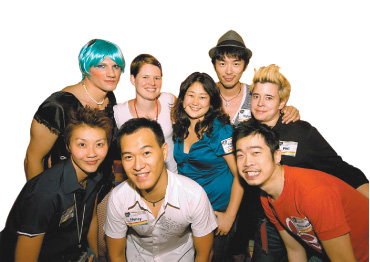However, I tried to find some information whether there was a second PRIDE festival in Shanghai in 2010, but did not find anything. According to other records, it took China a long time to abolish the "hooligan law", and it was not until 2001, when the Chinese Psychiatric Association removed homosexuality from its list of mental illnesses. Slowly but surely, China is progressing. There has even been some new terminology emerging for the gay community.
Similar to what we read in Wenshu Lee's article, "Kuaring Queer Theory: My Autocritography and a Race-Conscious, Womanist, Transnational Turn." Lee talks about how there is not a variety of words for the queer community, and makes up her own. The term Lee coins kua'er, is very similar to the one the community uses, ku'er. La'la is a term lesbians refer to and tong'zhi is commonly for what gays refer to.

I've noticed a very complicated relationship to gender and sexuality in Asian countries. I focus more on Japan in my cultural studies, however. Japanese animation, or anime, is very popular both in Japan and abroad. Within the culture surrounding anime, however, is a very large subculture making, purchasing, and celebrating gay shows, movies, and comics. When "gay" things are accepted in many western countries, lesbians tend to be accepted more readily, providing they are "femme" and fit into a mode of traditional feminine beauty. In this Japanese subculture, however, most of the material made and consumed features gay men, albeit men who are very feminized.
ReplyDeleteI visited Tokyo last spring break, and when I was there, I could walk into any bookstore and find clearly labelled gay comics, and when I took them to the counter to buy them, I was greeted courteously and my books were wrapped (this is normal for all books, not just certain ones).
In a few comic stores I visited in Akihabara, there wasn't even a distinction between comics. I could walk past a shelf with issues of popular kids comics like Bleach, Yu-Gi-Oh!, and One Piece, then see adult comics on the next page, with full nudity and various different sexualities.
Walking around the high fashion districts of Tokyo, like Shibuya and Shinjuku, it was also not uncommon to see people dressed in gender non-conforming ways. One of my favorite Japanese bands, Malice Mizer, was famous for "acting gay" on stage, and the former lead singer Gackt's sexuality is frequently debated amongst his fans and on television.
Despite all this, I wouldn't say that being gay is totally accepted in Japanese culture. I don't think it is taken seriously by most people, treated as a fetish, or a fashion statement, or a publicity stunt.